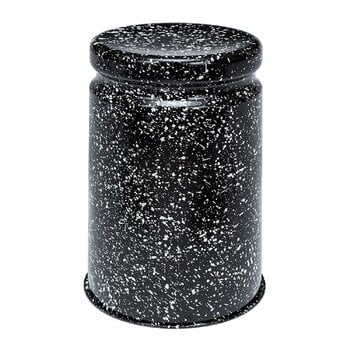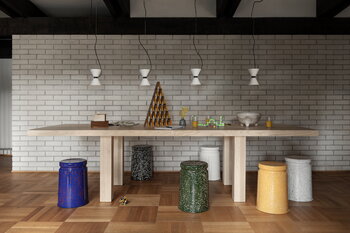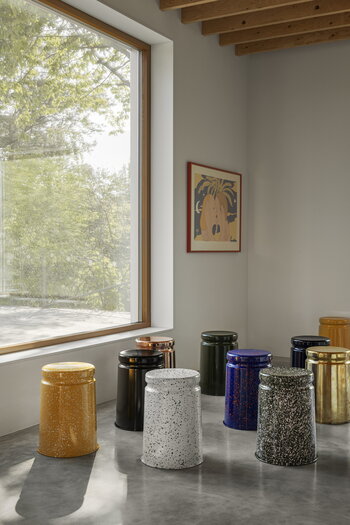Hem’s Last stool captivates with its distinctive expression. Crafted from enameled metal, the stool is extremely durable and stable, yet easy to lift and move around due to the handy indentation. The Last stool, designed by Max Lamb, is a versatile piece equally impressive at a dining table or as a nightstand or side table. Besides, it also works as a guaranteed conversation starter. The hand-splattered design makes every stool a unique piece of art.
Last stool, black - white splatter
Hem
Description
Hem’s Last stool captivates with its distinctive expression. Crafted from enameled metal, the stool is extremely durable and stable, yet easy to lift and move around due to the handy indentation. The Last stool, designed by Max Lamb, is a versatile piece equally impressive at a dining table or as a nightstand or side table. Besides, it also works as a guaranteed conversation starter. The hand-splattered design makes every stool a unique piece of art.
Product details (6)
- Colour
- Black, white
- Height
- 17.32 in (44 cm)
- Diameter
- 11.02 in (28 cm)
- Base diameter
- 12.6 in (32 cm)
- Material
- Enameled steel, handmade enameled splatter
- Weight
- 14.55 lbs (6.6 kg)
Designer
Max Lamb (born in 1980) is an acclaimed British designer known for his original – if not obstinate – design language: true to his unique approach, he creates modern classics that are often like pieces of art, yet still exceedingly functional. A graduate from London’s Royal College of Art, Lamb favors natural, uncomplicated materials like wood and metal, skilfully reshaping them with a combination of traditional and highly innovative methods.
View all productsReviews (0)
Sustainability
The Product Sustainability Framework, our criteria of sustainable design, helps you find the most sustainable products in our selection. Read below which sustainability criteria this product has met.
Working conditions & labour 8/9
-
Equal opportunities for all employees
-
Commitment to UN Global Compact, fair compensation for all employees
-
Corporate responsibility requirements defined and communicated for suppliers
-
Systematic work for improved inclusion and well-being in the workplace
-
Transparent supply chain
-
Suppliers' compliance to a code of conduct ensured
-
Compliance to the UN Guiding Principles on Business and Human Rights ensured in the supply chain
-
Support for community involvement in the supply chain
-
Direct suppliers audited and certified
Eco-friendly production 8/9
-
Fair and resource-wise water-use in production
-
No incineration or landfilling of returned items
-
No use of endangered species as materials
-
No direct environmental emissions or waste (excl. GHGs) from production
-
The sustainability of direct suppliers' production is addressed and monitored
-
Production and material sourcing that respect biodiversity, animal rights, and natural ecosystems
-
Material-efficient and ecological packaging
-
No potentially harmful chemicals used in own production
-
Positive impact on nature’s well-being through operations that regenerate natural ecosystems
Climate impact 4/8
-
Company's direct greenhouse gas emissions identified and commitment to reduction
-
Product's carbon impact identified and commitment to reduction
-
Guidance on energy- and eco-efficient use of the product
-
100 % renewable energy in own production and operations
-
Contribution to climate initiatives beyond the brand’s direct operations
-
Low-carbon or compensated transportation
-
Carbon footprint of the product calculated and goals set to reduce it
-
Carbon neutral or carbon negative product
Sustainable materials 5/6
-
Sustainable and long-lasting material choices
-
No harmful or hazardous substances
-
Responsible raw material sourcing and production
-
Materials suited for circularity: monomaterials, recyclable finishings, renewable or recycled contents etc.
-
Ecological materials: natural, biodegradable, recyclable or recycled contents
-
Outstanding materials in terms of innovativeness, responsibility, sustainability and circularity: local production or sourcing, 100 % recycled content, C2C-certification etc.
Circular design 4/5
-
High aesthetic quality promoting long-term use of the product
-
Technically durable product design and material choices
-
Design for enduring life-long quality
-
Design and support for product maintenance, repair and upgradability
-
Innovative circular design solutions: circular service system, resale platform, remanufacturing, collection of used products, etc.
Chat to us online
Please enable functional cookies to use this feature. You can change your cookie settings at any time.







